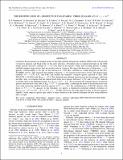THE IDENTIFICATION OF z -DROPOUTS IN PAN-STARRS1: THREE QUASARS AT 6.5< z < 6.7
Author(s)
Simcoe, Robert A.; Chen, Shi-Fan S.; Miller, Daniel Robert; Sullivan, Peter W.
DownloadVenemans-2015-The identification o.pdf (961.0Kb)
PUBLISHER_POLICY
Publisher Policy
Article is made available in accordance with the publisher's policy and may be subject to US copyright law. Please refer to the publisher's site for terms of use.
Terms of use
Metadata
Show full item recordAbstract
Luminous distant quasars are unique probes of the high-redshift intergalactic medium (IGM) and of the growth of massive galaxies and black holes in the early universe. Absorption due to neutral hydrogen in the IGM makes quasars beyond a redshift of z ≃ 6.5 very faint in the optical z band, thus locating quasars at higher redshifts requires large surveys that are sensitive above 1 micron. We report the discovery of three new z > 6.5 quasars, corresponding to an age of the universe of <850 Myr, selected as z-band dropouts in the Pan-STARRS1 survey. This increases the number of known z > 6.5 quasars from four to seven. The quasars have redshifts of z = 6.50, 6.52, and 6.66, and include the brightest z-dropout quasar reported to date, PSO J036.5078 + 03.0498 with M[subscript 1450] = -27.4. We obtained near-infrared spectroscopy for the quasars, and from the Mg ii line, we estimate that the central black holes have masses between 5 × 10[superscript 8] and 4 × 10[superscript 9] M[subscript ʘ] and are accreting close to the Eddington limit (L[subscript Bol]/L[subscript Edd] = 0.13 - 1.2). We investigate the ionized regions around the quasars and find near-zone radii of R[subscript NZ] = 1.5 - 5.2 proper Mpc, confirming the trend of decreasing near-zone sizes with increasing redshift found for quasars at 5.7 < z < 6.4. By combining R[subscript NZ] of the PS1 quasars with those of 5.7 < z < 7.1 quasars in the literature, we derive a luminosity-corrected redshift evolution of R[subscript NZ,corrected] = (7.2 ± 0.2) - (6.1 ± 0.7) x (z - 6) Mpc. However, the large spread in R[subscript NZ] in the new quasars implies a wide range in quasar ages and/or a large variation in the neutral hydrogen fraction along different lines of sight.
Date issued
2015-02Department
Massachusetts Institute of Technology. Department of Physics; MIT Kavli Institute for Astrophysics and Space ResearchJournal
The Astrophysical Journal. Letters
Publisher
IOP Publishing
Citation
Venemans, B. P., E. Banados, R. Decarli, E. P. Farina, F. Walter, K. C. Chambers, X. Fan, et al. “THE IDENTIFICATION OF z -DROPOUTS IN PAN-STARRS1: THREE QUASARS AT 6.5< z < 6.7.” The Astrophysical Journal 801, no. 1 (February 27, 2015): L11. © 2015 The American Astronomical Society
Version: Final published version
ISSN
2041-8213
2041-8205